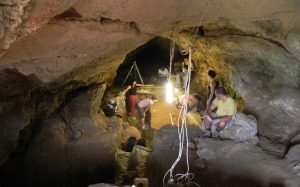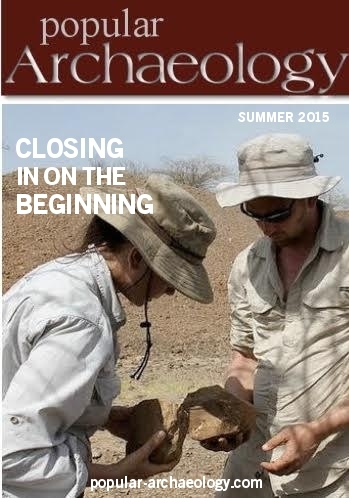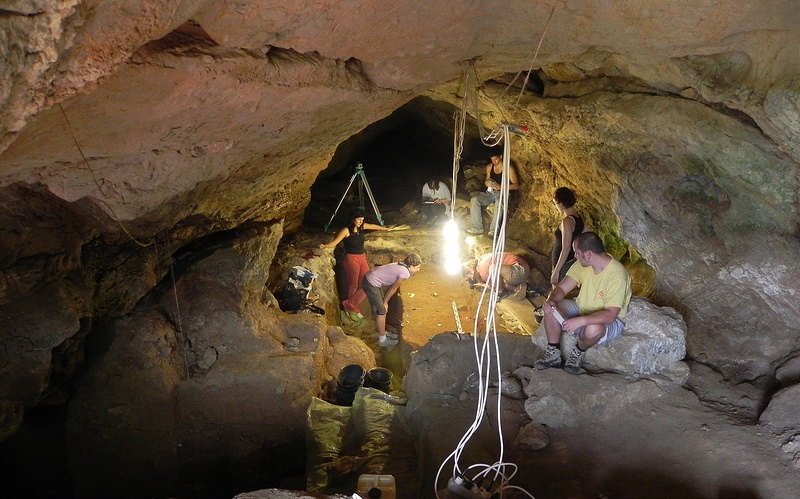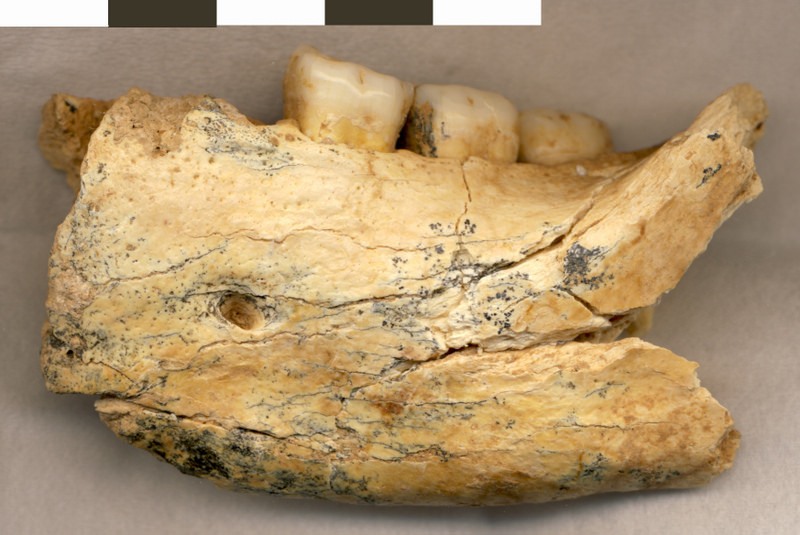
In 2011, Popular Archaeology Magazine published an article by Mirjana Roksandic, a prominent paleoanthropologist with the University of Winnipeg, touching on the discovery of a partial hominin mandible in the Mala Balanica cave in the Sicevo Gorge in Serbia.
With the new release of that article entitled The Road through Sicevo as a free access article, the findings related to the mandible are now updated based on the publication of Roksandic’s later paper, The Role of the Balkans in the Peopling of Europe: New Evidence from Serbia. That paper explained that Electron Spin Resonance and Thermoluminescence dating have suggested a date range between 395 and 525 Kya for the age of the subject fossil. The testing and study was conducted by an international team of researchers that included William Jack Rink of McMaster University, Canada, Dušan Mihailović, University of Belgrade, Serbia, and Mirjana Roksandic, University of Winnipeg, Canada.* Mihailović and Roksandic were both involved in the initial discovery of the ancient mandible (scientifically labeled “BH-1”) in 2008.
The dating now supports the observable primitive morphology of the mandible with that of an early Middle Pleistocene archaic human, although different from hominin fossils found for the same time period in the western regions of Europe. Significant to the research on Middle Pleistocene human evolution in Europe and Southwest Asia, the mandible bears characteristics not attributable to any species with Neanderthal features, or Neanderthal derived features. This includes Homo heidelbergensis, an early human species long generally accepted to be a possible ancestor to Neanderthals in Europe. Overall, these new findings have implied a possible evolutionary and human dispersal picture that is more complex than previously thought, with the Balkans representing “the only refugium that never experienced isolation,” and therefore playing a role “in maintaining gene flow and allowing primitive traits to remain present in the population for a longer period of time.”**
____________________________________________
Excavations underway in the Mala Balanica cave. Courtesy Mirjana Roksandic
____________________________________________
Partiable mandible BH-1, discovered in the Mala Balanica Cave in 2008. From Rink WJ, Mercier N, Mihailovic´ D, Morley MW, Thompson JW, et al. (2013) New Radiometric Ages for the BH-1 Hominin from Balanica (Serbia): Implications for Understanding the Role of the Balkans in Middle Pleistocene Human Evolution. PLoS ONE 8(2): e54608. doi:10.1371/journal.pone.0054608 Courtesy Mirjana Roksandic
__________________________________________________________
See the premium article about this subject, now released as a free article.
____________________________________________
*Rink WJ, Mercier N, Mihailovic´ D, Morley MW, Thompson JW, et al. (2013) New Radiometric Ages for the BH-1 Hominin from Balanica (Serbia): Implications for Understanding the Role of the Balkans in Middle Pleistocene Human Evolution. PLoS ONE 8(2): e54608. doi:10.1371/journal.pone.0054608
**Mirjana Roksandic, The Role of the Balkans in the Peopling of Europe: New Evidence from Serbia, Recent Discoveries and Perspectives in Human Evolution, Manchester 2013
__________________________________________
 Read more in-depth articles about archaeology with a premium subscription to Popular Archaeology Magazine.
Read more in-depth articles about archaeology with a premium subscription to Popular Archaeology Magazine.
In addition, the latest Popular Archaeology ebook is now available.
______________________________________________
Travel and learn with Far Horizons.
____________________________________________
 This richly illustrated ebook version of a recent Popular Archaeology issue includes the following stories: The discovery of the tomb of a previously unknown pharaoh that is shedding light on a lost ancient Egyptian dynasty; how genetics is revolutionizing what we know about human evolution and our prehistoric past; one scholar’s controversial ‘New Chronology’ and how it supports the historicity of the biblical Exodus; how archaeologists are unearthing new history in Williamsburg, Virginia, a seat of British colonial power in 18th century America; the discovery of the remains of a major Roman legionary base in Israel; the unearthing of an ancient Judean fortified settlement in the borderlands between the biblical kingdoms of ancient Judah and the Philistines; and how archaeologists are uncovering evidence of what may have been an important administrative center of Judah during the 8th century BCE. Now available from Amazon.com!
This richly illustrated ebook version of a recent Popular Archaeology issue includes the following stories: The discovery of the tomb of a previously unknown pharaoh that is shedding light on a lost ancient Egyptian dynasty; how genetics is revolutionizing what we know about human evolution and our prehistoric past; one scholar’s controversial ‘New Chronology’ and how it supports the historicity of the biblical Exodus; how archaeologists are unearthing new history in Williamsburg, Virginia, a seat of British colonial power in 18th century America; the discovery of the remains of a major Roman legionary base in Israel; the unearthing of an ancient Judean fortified settlement in the borderlands between the biblical kingdoms of ancient Judah and the Philistines; and how archaeologists are uncovering evidence of what may have been an important administrative center of Judah during the 8th century BCE. Now available from Amazon.com!
____________________________________________
Roksandic concludes: “While isolation [due to glaciation] represented the major mechanism of evolutionary change in the west of the continent, causing a bottleneck and fixation of derived traits, the [warmer refuge of the] Balkan Peninsula did not experience the effects of isolation.”*
The findings also support the model of the Balkans as a critical connecting region with Southwest Asia in the dispersal of humans, possibly consisting of multiple major migrations.
________________________________________________________
See the article, The Road through Sicevo, now released as a free article from the Popular Archaeology Magazine archives.
*M. Roksandic, The Role of the Balkans in the Peopling of Europe: New Evidence from Serbia, Recent Discoveries and Perspectives in Human Evolution, Manchester 2013.
________________________________________________________
 Read more in-depth articles about archaeology with a premium subscription to Popular Archaeology Magazine.
Read more in-depth articles about archaeology with a premium subscription to Popular Archaeology Magazine.
In addition, the latest Popular Archaeology ebook is now available.
______________________________________________
Travel and learn with Far Horizons.
____________________________________________
 This richly illustrated ebook version of a recent Popular Archaeology issue includes the following stories: The discovery of the tomb of a previously unknown pharaoh that is shedding light on a lost ancient Egyptian dynasty; how genetics is revolutionizing what we know about human evolution and our prehistoric past; one scholar’s controversial ‘New Chronology’ and how it supports the historicity of the biblical Exodus; how archaeologists are unearthing new history in Williamsburg, Virginia, a seat of British colonial power in 18th century America; the discovery of the remains of a major Roman legionary base in Israel; the unearthing of an ancient Judean fortified settlement in the borderlands between the biblical kingdoms of ancient Judah and the Philistines; and how archaeologists are uncovering evidence of what may have been an important administrative center of Judah during the 8th century BCE. Now available from Amazon.com!
This richly illustrated ebook version of a recent Popular Archaeology issue includes the following stories: The discovery of the tomb of a previously unknown pharaoh that is shedding light on a lost ancient Egyptian dynasty; how genetics is revolutionizing what we know about human evolution and our prehistoric past; one scholar’s controversial ‘New Chronology’ and how it supports the historicity of the biblical Exodus; how archaeologists are unearthing new history in Williamsburg, Virginia, a seat of British colonial power in 18th century America; the discovery of the remains of a major Roman legionary base in Israel; the unearthing of an ancient Judean fortified settlement in the borderlands between the biblical kingdoms of ancient Judah and the Philistines; and how archaeologists are uncovering evidence of what may have been an important administrative center of Judah during the 8th century BCE. Now available from Amazon.com!
____________________________________________






